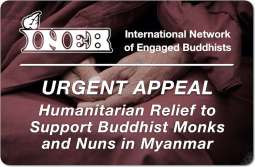T'an-luan (476-542)
Early Chinese Pure Land thinker and popularizer. He began his monastic career as a scholar, and was in the middle of composing a massive commentary on the Mahāsaṃnipāta Sūtra (Chinese, Ta-chi ching) when he came down with a serious illness. He left his monastery and sought out a renowned Taoist alchemist to receive the teachings on immortality. After receiving from him ten scrolls of Taoist scripture, he set out for home. However, on his way back he reportedly ran into the Indian monk Bodhiruci. T'an-luan asked him if there were any Indian Buddhist sūtras better than Taoist works on immortality. At this Bodhiruci is said to have become very angry and spat on the ground, saying that one cannot find the secret of immortality in any Chinese book. Taoism may prolong your life for a while, but by means of its teaching one cannot escape death. Bodhiruci then taught T'an-luan the practice of reciting the name of Amitābha, here significantly called by his other name Amitāyus, which means ‘infinite life’. T'an-luan believed, and threw away his magic formulae and set himself to the practice of reciting Amitābha's name. T'an-luan is then said to have thrown away his books and adopted Bodhiruci's teaching wholeheartedly, but there is some doubt about this, as ancient bibliographies list works on Taoist topics under his name and some scholars continue to identify Taoist themes even in his later Buddhist works.
What is historically significant for the development of Pure Land Buddhism is: (1) the single-minded way T'an-luan set about Pure Land practices; (2) his reliance on the ‘other-power’ of Amitābha to bring him to the Pure Land; and (3) the fact that he turned his devotion into a mass movement. In terms of the first point, whereas before his illness he had been a fairly typical, well-rounded monk, engaging in scholarship and cultivating different meditations, after his ‘conversion’ he came to rely solely on Pure Land practices, reflecting a growing pessimism about the suitability of this world as a place to practise. This was a significant development. Second, after his illness he clearly grew despondent about his own power to affect his destiny, and so he responded to the teaching that the power of Amitābha's vow was sufficient to bring him to a better world. Now one begins to see what will become a dominant theme in Pure Land Buddhism, especially in Japan: the opposition between the ‘self-power’ (jiriki) of the practitioner and the ‘other-power’ (tariki) of Amitābha. This was related to two historical factors: the almost constant state of war that existed in north China at the time, and the growing acceptance of the division of Buddhist history into three periods, each marked by the decreasing efficacy of traditional Buddhist practices. Feeling that the third and worst period (mappō) was either imminent or already present, many came to believe that individual initiative and power were either useless or of sharply reduced efficacy, and sought help from other powers outside themselves.
T'an-luan advocated five related practices in his Commentary on [Vasubandhu's] Upadeśa on the Sūtra of Immeasurable Life (Taishō 1819), which Bodhiruci had translated earlier: (1) worshipping Amitābha; (2) praising his name; (3) vowing constantly to be reborn in the Pure Land; (4) meditating on the Pure Land, probably through visualizing it; and (5) transferring the merit (puṇya) one attains through this practice to helping all sentient beings. However, he placed the greatest emphasis on the first practice, worshipping or reciting Amitābha's name. Through this, even one who has committed the five great offences (with the exception of slandering the teachings) can be reborn in the western Pure Land. The purpose of rebirth in the Pure Land, he taught, is to return to this earth in order to save others. T'an-luan stands as one who took Pure Land practice out of the matrix of Buddhist religious practices and popularized it as a self-standing expedient for those who, in this troubled time, cannot engage in the rigours of meditation and monastic life.













